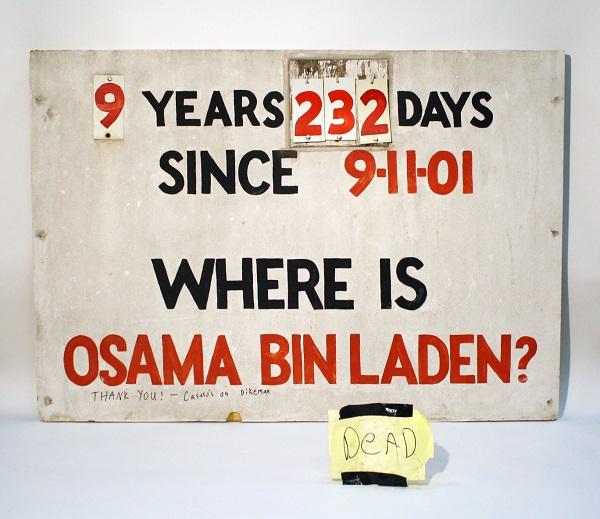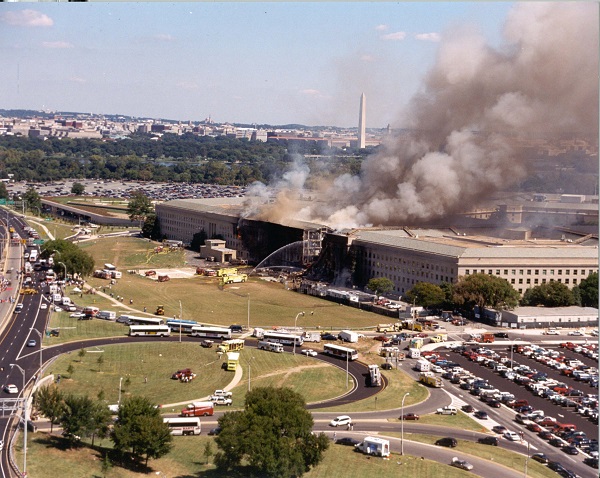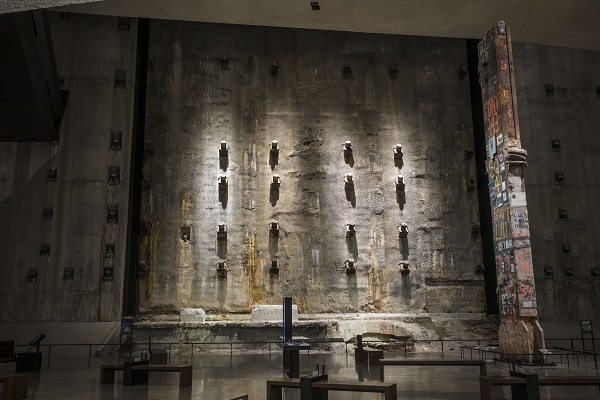Make a donation to the museum
Artifact Tells the Story of the Nine-Year Search for Osama bin Laden
Artifact Tells the Story of the Nine-Year Search for Osama bin Laden

On this day in 2011, Osama bin Laden was killed by U.S. forces in a raid of his compound in Abbottabad, Pakistan. The 9/11 Memorial Museum collection is home to several artifacts related to this event, including the artifact described below, which is currently on view in the Museum’s historical exhibition.
On September 11, 2001, Cheryl Stewart watched in disbelief from the roof of her Red Hook home as a plume of black smoke wafted across the sky from lower Manhattan toward Brooklyn. Despite the horrific view, she felt confident that the Twin Towers would be standing tall when the smoke cleared.
Days later, after registering the enormity of human and physical losses on 9/11, Stewart, who’s a sculptor and scenic artist, feared that the invincible spirit of New York would never be the same again. As time passed, she worried that New York lay vulnerable to further terrorist attacks, which would perpetuate a reactionary atmosphere of fear in a place renowned for its free spirit.
In 2003, with war declared in Iraq and a search underway for so-called weapons of mass destruction, the politically-conscious Stewart decided to transform her front yard into a silent protest. She posted a marquee posing the question, “Where is Osama bin Laden?” The sign tracked the number of days the world’s most elusive terrorist remained free.
Aware of the loss of American lives in the 1998 U.S. Embassy bombings in East Africa, followed by the USS Cole attack in 2000, Stewart was familiar with bin Laden’s reign of terror before the September 11, 2001 attacks.
She felt frustrated that the efforts to locate and apprehend him faltered while war waged on in the name of retribution for the 2001 attacks he orchestrated. Her idea to keep a public record of bin Laden’s days at large originated from tabloid coverage of the 1979 Iranian hostage crisis, which included a prominent counter clock that had reached 444 days before those 52 U.S. citizens were finally released.
When the news broke May 1, 2011, that a special team of U.S. Navy SEALs finally had located and eliminated bin Laden, who hid with relatives in a heavily fortified bunker in Abbottabad, Pakistan, Stewart finally received the answer to the long-standing question articulated on her lawn sign.
The sign’s final posting the day of bin Laden’s death read, “9 years 232 days since 9-11-01: Where is Osama bin Laden?” A passerby scrawled “dead” on a piece of torn yellow notebook paper taped to the sign sometime after midnight. Stewart, who had just returned home from the hospital after receiving treatment for broken bones she suffered in a motorcycle accident, removed the sign with the help of neighbors thereafter.
In May 2011, Stewart donated it to the 9/11 Memorial Museum, marking the Museum’s first artifact dramatizing the historic milestone of bin Laden’s capture and death.
By Alexandra Drakakis, Curator, 9/11 Memorial Museum
Previous Post
Pentagon Survivor Kathy Dillaber Tells Her 9/11 Story

On September 11, 2019, Kathy, along with four others, will share her story as a part of this year’s fourth annual Anniversary in the Schools webinar.
Next Post
Public Program at the 9/11 Memorial Museum to Highlight Unique History of the Slurry Wall

On Monday, May 6, the 9/11 Memorial & Museum will host a panel discussion between Harriet Senie, Ken Lustbader and Peter Rinaldi about the history and cultural significance of the World Trade Center slurry wall.